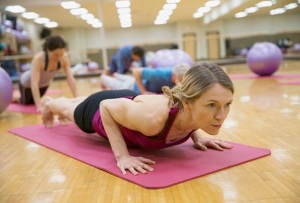Find out 5 benefits of this popular exercise as well as some tips for getting started.
One simple exercise, endless variations and an unbeatable core workout — planking has more benefits than one. But have you given it a try? Where do you even begin?
Tip: Before you begin any new exercise routine, always consult your physician.
How to Plank
In its most basic form, the exercise is pretty straightforward. First, lie on your stomach on the floor, then push up onto your toes and elbows and hold the position with your elbows directly under your shoulders.
Tighten your abdominal muscles and keep the rest of your b
ody aligned in a straight “plank-like” line. Hold the position as long as possible. If you need to start with an easier position, try planking on your elbows and knees, rather than your elbows and toes.
Tip: How long you plank will depend on your level of fitness. At first you may only be able to plank for 10 or 20 seconds. If your fitness level is higher, you might start with a 30- or 60-second plank. Time yourself. Each day try to hold a plank for another five or 10 seconds. Feeling ambitious? After completing a plank, take a brief rest and do it again.
What Makes the Planking so Great?
If you haven’t tried planking yet, here are five reasons why you should start:
You can do it anywhere, any time with absolutely no equipment. Your body weight and gravity provide the resistance.
The plank engages muscles in your shoulders and throughout your core. Core muscles are essential for stability, balance and posture.
There are infinite variations of the plank, so it’s easy to ramp up the intensity as you develop your strength or to add new twists if you start to get bored.
While most abdominal exercises are performed facing up, the plank is performed facing down, so you’re not straining your neck or back.
The plank can help increase lower back strength, reducing the risk of injury.
Mix it up: Plank Variations
Once you’ve mastered the basic plank and can maintain the position for at least a minute or more, you may want to spice up your routine. Give one of these variations a try:
Side Planks: Lie on your side and push up into a plank position, supporting your upper body on one elbow. Lift your top arm and point it toward the ceiling. When you’re finished, switch sides. This is a great exercise for your oblique muscles, which run down the side of your torso.
Raised-leg Plank: Working from an elbow plank position, lift one leg off the ground and hold the position for 30 seconds, and then switch legs.
Toe Points: From a plank position, lift one leg a few inches off the floor, point your toes and slowly kick your leg out to the side 5-10 times. Repeat with your other leg.
Knee to Elbow: Lift one leg, point your toes and slowly bring your knee out to the side toward your elbows. Repeat the move 5-10 times, and then switch to the other side.
Plank Pushups: From a plank position, “walk” up onto your hands and then back down to your elbows. Repeat 10 times.
Alternating Leg and Arm Lift: From the plank position, raise your left leg and right arm. Hold a few seconds. Switch sides and do the same, alternating back and forth.
As with all exercises, listen to your body. If a position seems to put undue strain on part of your body, stop doing the exercise or consult your physician.
What is your Favorite Plank? Please leave me a comment or contact me so you can receive my monthly Newsletter!

